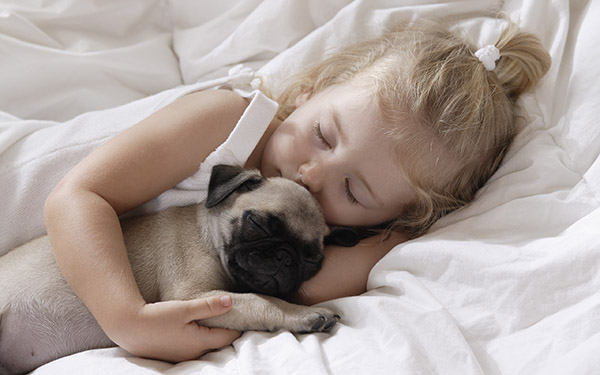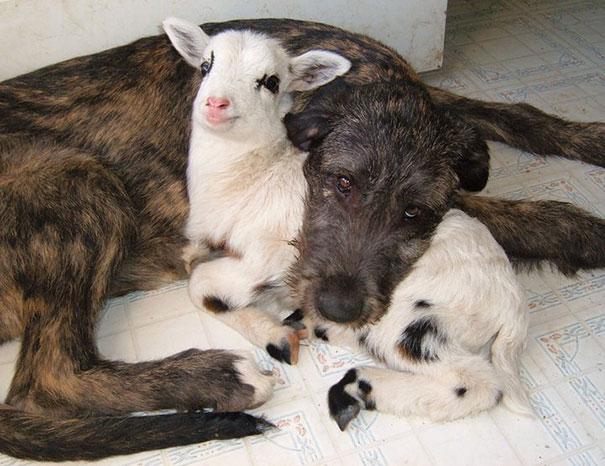
I'm not a dog person. I prefer cats. Cats make you work to have a relationship with them, and I like that. But I have adopted several dogs, caving in to pressure from my kids. The first was Teddy, a rottweiler-chow mix whose bushy hair was cut into a lion mane. Kids loved him, and he grew on me, too. Teddy was probably ten years when we adopted him. Five years later he had multiple organs failing and it was time to put him to sleep.
When I arrived at the vet, he said I could drop him off. I was aghast. No. I needed to stay with Teddy. As the vet prepped the syringe to put him to sleep, I started sobbing. The vet gave me a couple minutes to collect myself and say goodbye. I held Teddy's paw until he died. Honestly, I didn't think I was that attached.
This experience led me to undertake experiments on animal-human relations to try to understand how animals make us care so much about them. Biologically, I wanted to know if pets cause the people to release oxytocin, known as the neurochemical of love, and traditionally associated with the nurturing of one's offspring.
My lab at Claremont Graduate University in California pioneered the study of the chemical basis for human goodness. In the past decade, we have done dozens of studies showing that the brain produces the chemical oxytocin when someone treats us with kindness.
I call oxytocin the "moral molecule" because it motivates us to treat others with care and compassion. Oxytocin was classically associated with uterine contractions in humans, and in rodents caring for offspring. Our studies showed that a large number of agreeable human interactions—from trusting a stranger to hold money for you, to dancing, to meditating in a group—causes the release of oxytocin and, at least temporarily, makes us tangibly care about others, even complete strangers.
In our animal experiment, 100 participants came into my lab and we obtained blood samples from them to establish their baseline physiologic states. Then they went into a private room and played with a dog or cat for 15 minutes. We did a second blood draw after this, and then had participants interact with each other to see how they behaved toward humans, too. If animals caused oxytocin release in humans, it would explain my surprise attachment to my dog Teddy, and perhaps why people spend thousands of dollars to treat a pet medically rather than euthanize it and simply get a new animal.
Our previous studies showed that when humans engage in social activities with each other, oxytocin levels typically increase between 10 percent and 50 percent. The change in oxytocin, measured in blood, indexes the strength of the relationship between people. When your little daughter runs to hug you, your oxytocin could increase 100 percent. When a stranger shakes your hand, it might be 5 or 10 percent. If the stranger shaking your hand is attractive, oxytocin might increase 50 percent. Oxytocin is considered a reproductive hormone. It increases powerfully during sexual climax, establishing long-term bonds between romantic partners. Our experiments focus on what causes the brain to make oxytocin and its behavioral effects.

The dog and cat study showed that neither species consistently increased oxytocin in humans. Only 30 percent of participants had an increase in oxytocin after playing with an animal. We found that one factor predicted whether playing with a dog would increase oxytocin: the lifetime number of pets of any type one had owned.
The opposite was true for those who interacted with cats. Greater lifetime pet ownership caused oxytocin to fall linearly. Dogs are simply more "people-oriented" than cats, and previous pet ownership seems to have trained our brains to bond with them.
We also found that dogs reduced stress hormones better than cats (no surprise there!). When stress hormones were lower, people in the experiment trusted strangers with more of their own money. This may tell us why people who own dogs are judged as more trustworthy than those who don't. The human-canine bond appears to be powerful and important to both species.
Many dogs, and sometimes other mammals, exhibit another human-like behavior: play. I was curious if animals can form friendships with other animals and was invited to take part in a small-scale experiment for BBC television that would give me a chance to test this.
As in our laboratory experiment, I wanted to see if cross-species animal play causes oxytocin synthesis. This would be biological evidence for animal friendships. That's how I ended up in Arkansas with a goat in my lap.
At an animal refuge in Arkansas, where a large variety of animals interact with one another, I obtained blood samples from a domestic mixed-breed terrier and a goat that regularly played with each other. Their play involved chasing each other, jumping towards each other, and engaging in simulated fighting (baring teeth and snarling). Both animals were young males. We then placed the dog and goat into an enclosure together and let them play. A second blood sample was done after 15 minutes.

facebook.com/rockyridgerefuge
We found that the dog had a 48 percent increase in oxytocin. This shows that the dog was quite attached to the goat. The moderate change in oxytocin suggests the dog viewed the goat as a "friend."
More striking was the goat's reaction to the dog: It had a 210 percent increase in oxytocin. At that level of increase, within the framework of oxytocin as the "love hormone," we essentially found that the goat might have been in love with the dog. The only time I have seen such a surge in oxytocin in humans is when someone sees their loved one, is romantically attracted to someone, or is shown an enormous kindness.
Charles Darwin, in his 1872 book The Expression of the Emotions in Man and Animals argued that emotions are conserved across species, including dogs, goats, and humans. That animals of different species induce oxytocin release in each other suggests that they, like us, may be capable of love. It is quite possible that Fido and Boots may feel the same way about you as you do about them. You can even call it love.
Via TheAtlantic.com / Please visit TheMoralMolecule.com to read more of Paul J. Zak's work!

No hay comentarios:
Publicar un comentario